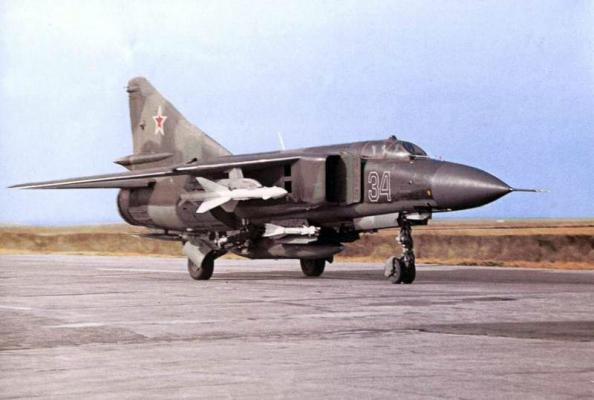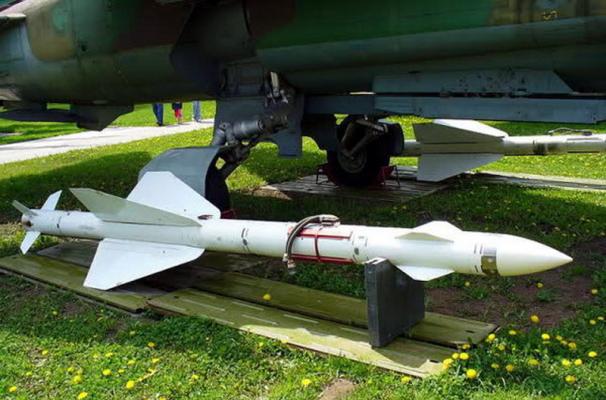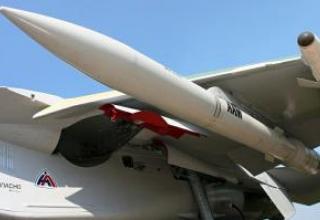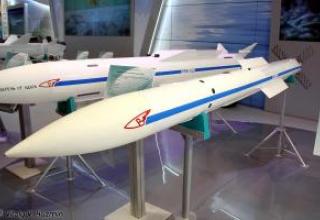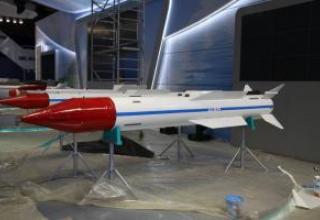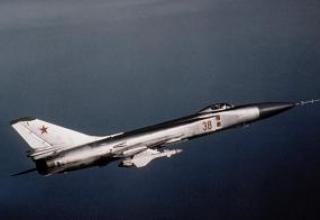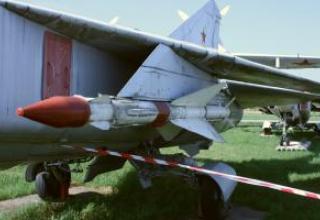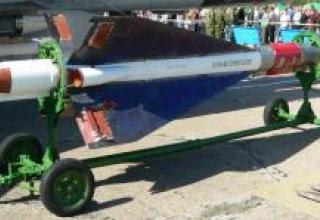Even before the adoption of the MiG-23M with the R-23 by a joint decision of the Air Force, the Ministry of Aviation and Defense Industry in 1973 began to develop an improved version of the K-23M, which was carried out on "Vimpel" under the leadership of V.A. Pustovoytov. The radar homing head "Topaz-M" (RGS-23M, 9B-1022) was created under the general leadership of E.I. Genishta, and M.N. Gushchin became its deputy. Detailed work plan was approved by the decision of the military-industrial complex on April 10, 1974. for equipping the K-23M aircraft MiG-29 and MiG-23 in versions ML and M. To achieve maximum combat efficiency was used a more powerful engine, a new power unit, providing a long flight for extended range, an improved fuse.
In the same 1974, were produced experimental missiles with the maximum use of elements of the standard R-23, but already equipped with SN Topaz-M. In 1975, released a sketch draft of an improved version of the rocket, which by that time received the designation of K-24. Due to the high degree of continuity with the R-23, production of the mattress was fast. In the same 1975 were made two ballistic launches of "products 142" with a free-standing ground installation, under a new missile re-equipped MiG-23M number 7110. In accordance with the decision of the military-industrial complex from the beginning of next year were planned to test with the MiG-23ML No.125 and 126. The same document provided for the development of passive radar CNS for firing at aircraft type AVAKS, but this direction was implemented much later, already in the case of K-27 missiles. The following year, 1976, eight launches of "products 142" completed factory tests. Another year later, the main volume of state tests was completed, to conduct which were additionally involved in the MiG-23M ¹ 8530 and a number of prototypes of MiG-23ML (No.124, 125, 126). However, identified weaknesses of the CNS required additional improvements, so that flights and rocket launches continued until 1979. The stability of the aircraft engine during the launch of missiles was studied on the MiG-23ML No. 125.
The initial design of the K-24 missile was determined by the prospect of using the new radar GOS. However, as a result, a missile was created, almost all elements of which surpassed the R-23 by the level of perfection. It was absurd to maintain the production of R-23T in parallel with the "radius" of K-24. Besides, some prospects for further improvement of the thermal GOS were revealed. As a result, the development of the K-24T ("product 160") began by the decision of the MIC on April 4, 1975. The conceptual design was released in 1976, but a number of missile elements were manufactured a year earlier. However, due to a delay of "Geophysics" with the development and delivery of the head 23T4 flight tests began only in 1978 with two launches from the ground and 11 - with the MiG-23ML number 125 and MiG-23P number 142. The following year, six program and eight controlled launches of thermal K-24 were conducted, and aircraft No 141 joined the tests.
In 1979 there were launched 14 combat and two autonomous missiles, completing the second stage of state tests by signing the relevant act in early 1980. The next year the act of the State Commission with recommendation to adopt the missile was approved. Prototypes of MiG-23ML (No.124 and 125) and its modifications for the MiG-23P air defense (No. 141 and 142), as well as "sparka" MiG-23UB (No. 1301 and 202) participated in the flight tests of the thermal version.
Formal adoption of the new missile as a standard weapon of the MiG-23ML and MiG-23P was carried out by a decree of April 6, 1981.
R-24 missiles were successfully used from MiG-23ML aircraft during the armed conflict in South Lebanon in 1982. According to the Syrian side, these fighters managed to shoot down three F-15 and one F-4 with a "dry count".
Later the missile underwent another modernization in accordance with the joint decision of the Air Force, the Ministry of Radio Industry and Aviation Industry of October 28, 1983. Already in 1984, the first four launches of K-24M missiles equipped with improved GSN were conducted. In 1985, with the MiG-23M ¹ 420 carried out launches of four combat and one telemetry K-24M, including a jammer Tu-16 and a helicopter Mi-4, standing on the ground with a running engine and rotating propeller. In 1986, carried out another eight launches on the MiG-21, simulating cruise missiles, after which the R-24M ("product 140M") was adopted for service.
In 1981, a version of the missile with an active radar CNS was considered. Despite the positive results of research, this direction has not been implemented: the main forces of the designers had to focus on creating active SLN for more modern missiles.
In the Russian Air Force, R-24 missiles remained in service until 1997. As part of the MiG-23 fighters, the missile was exported to many countries, among them: Afghanistan, Algeria, Angola, Bulgaria, North Korea, Cuba, Ethiopia, Germany, India, Iraq, Yugoslavia, Libya, Poland, Romania, Czech Republic, Syria, Slovakia, Sudan, Hungary and others.
In the west, R-24R was designated Apex AA-7C and R-24T was designated Apex AA-7D.
On the whole, the development of the K-24 missile has become a milestone in the history of domestic rocket building. Due to the implementation of the original scheme of operation for the first time it was possible to achieve superiority in maximum range over the U.S. counterparts armament of front-line aircraft.
Composition:
The P-24 missile (see projections) is shaped according to the normal aerodynamic scheme with destabilizers located on the homing head housing. The missile can be equipped with a semi-active homing radar head (R-24P) or a thermal head (R-24T). On the radar R-24R ("product 140") used a new homing head RGS-24 (9B-1022), on the R-24T ("product 160") - an improved all-angle infrared TGS-23T4, photoreceiver which was cooled with nitrogen to -195°C. Dimensions and position of the destabilizers are selected depending on the type of GSN used so as to keep the torque characteristics of the missile unchanged.
The most noticeable external difference of the new missile from the P-23 was the use of wings with backward sweep along the rear edge. The internal layout has also changed, and the number of compartments has been reduced from 8 to 5. The first compartment was traditionally the homing head. The second compartment sequentially housed a radio detonator "Squaretz", autopilot and a turbine generator working from a special gunpowder pressure accumulator. The core combat unit with a radius of destruction of 10 m and the safety executive mechanism was moved to the third compartment. The PRD-287 solid fuel engine formed the fourth compartment. The engine has an extended operating time, provides greater range and speed up to M=3.5 . In the fifth compartment around the elongated gas flow nozzle was placed a block of gas generators, providing power to the steering machines.
Semi-active radar homing head RGS-24 (9B-1022) compared to the prototype has increased noise immunity and range. Due to the implementation of the so-called "pseudo kinematic link" with an analogue computing device, the duration of autonomous flight was increased to 10s, which allowed, regardless of aiming errors, to hit targets at a distance 30% higher than the maximum range of target acquisition CNS. As a result, the launch range in the front hemisphere was increased from 25 to 32 km, in the rear - from 15 to 20 km.
Overloads were integrated in the SSS 9B-1022 equipment units, which provided inertial control in the autonomous flight section, and after the target was captured for auto tracking - filtration when assessing the angular velocity. This was done by means of a kinematic relations model built in a rotating coordinate system using a range line as the X-differential equation axis linking the angular velocity of the sighting line to the projection of the missile's overload on its orthogonal plane. The coefficients of these equations are the relative range and approach velocity, which are also calculated by integrating the corresponding overload projection. The initial conditions necessary for calculating the angular velocity of the range line are formed in the rocket's calculator during the development of the angular target designation while the missile is still in suspension. The function of the calculator, as a result of which the angular velocity of the range line is predicted, starts from the moment of descent, and the model uses measurements of the missile's overload in projections on the antenna axes, as well as measurements of the missile's angular velocity relative to the missile's longitudinal axis. This results in an estimate of the angular velocity of the range line, which is necessary to control the missile and the antenna head, while the head does not capture the target. The use of inertial control before target acquisition by the head made it possible to fully exploit the missile's launch error correction capabilities. The ratio between the allowable launch range and the capture range proved to be independent of launch errors.
In the P-24R missile's control system, the model of kinematic relations in a rotating coordinate system associated with the range line is used even after capture as a filter for estimating angular velocity. Thus, in the R-24R control system, a Kalman filter of the Kalman structure was used for the first time to filter and form controls, using as the core of the filter the object model - kinematic relations connecting the angular velocity of the range line and relative acceleration.
The upgraded R-24 (R-24M) missile has a significantly higher efficiency. For the first time, R-24M was provided with firing at hovering helicopters and selective targeting of a target flying in a dense group. The possibility of hitting maneuvering and low-altitude targets has increased, as well as protection from combined and interference.
The R-24 missile is placed on a modified launcher - APU-23M1.
Characteristics:
| R-24R | R-24Т | |
| Maximum launch range in the front hemisphere, km | 50 | 35 |
| Minimum launch range in the rear hemisphere, km | 0.5 | 0.5 |
| Flight height of targets, km | 0.04 -25 | |
| Dimensions, mm: - length - diameter - wingspan - steering wheel range |
4494 200 1000 646 |
4218 200 1000 646 |
| Starter weight, kg | 245 | 238 |
| Weight of combat unit, kg | 35 | 35 |
| Time of controlled flight, s | 45 | 45 |
| Time of controlled flight, units | 5 | 5 |
Testing:
Having unique flight and tactical characteristics, MiG-25P for a long time was operated only as part of the Soviet air defense fighter aircraft. In the early 1980s, its delivery abroad began, and soon its baptism of fire took place. Even before the beginning of the large-scale Lebanese conflict, in spring 1981, the Syrians announced the destruction of the F-15.
According to the Iraqi Air Force Command, from December 1982 to October 1986, during the Iran-Iraq war, the Iraqi MiG-25 shot down an Iranian F-5E fighter, an EU-130E counter-electronic aircraft, and three Phantoms, including one in a reconnaissance version.
During Operation Desert Storm, January 17, 1991, Iraqi MiG-25 managed to shoot down an American F/A-18, and in 2002 - an unmanned reconnaissance drone Predeitor.
Sources:
- В.Марковский, К.Перов Советские авиационные ракеты "воздух-воздух"-М.: ООО "Издательский дом "Экспринт", 2005.-48с.
- Vympel R-23 e R-24 (AA-7 Apex)
- Очерк истории создания отечественного управляемого оружия класса "воздух - воздух"
- Отечественные ракеты воздух-воздух
